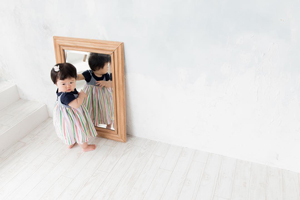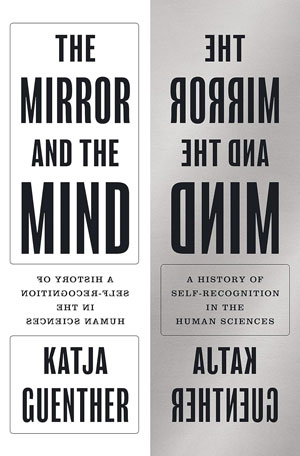
The Mirror and the Mind traces the history of the mirror self-recognition test—the experiment of placing subjects in front of a mirror and looking for signs of self-recognition—showing how it became a privileged site for addressing questions about human nature.
From its origins in the Enlightenment period, the mirror test provided a way of reconciling notions of human specificity with discourses, such as Darwinism, that threatened to dissolve the boundaries between humans and other creatures. Babies might begin with mental capabilities comparable to those of lower animals, but once they were able to recognize themselves in a mirror (at around 18 months), they breached a new level of existence, and left all other animals behind.
The high hopes placed in the mirror, however, were soon put to a serious test. As I show in the book, the responses to the mirror were surely suggestive, but it turned out to be extremely difficult to know exactly what they meant. If an animal attacked the mirror, did this suggest that it took the mirror image to be another animal? If a child smiled at its image, was this a sign of self-recognition? In response, researchers developed a set of methods, standardizing mirror situations, building national and international networks of baby observation, and relying on a set of media of observation such as note-taking, film, and video. In the course of these developments, the earlier ambitious goals of mirror testing were sometimes lost: instead of self-recognition, the mirror was used to elicit a specific set of behaviors related to other social and cognitive functions.

By following the mirror through a range of historical contexts, The Mirror and the Mind offers a new way of understanding the history of psychology. While the standard history of psychology is told as a succession of movements, tracing its beginnings in the experimental psychology of Wilhelm Wundt (1832-1920) through the behaviorist critiques of introspection, to the rise of cognitivism and neuroscience,the mirror test carves a different path through the mind sciences. It did not constitute a tradition as normally understood. Although some mirror experimenters drew on a network of intellectual references, many were not aware of these connections. What holds the actors in the book together is rather a shared set of material practices centered on the mirror as a piece of experimental equipment. As such it guides us along the backroads of psychology, giving new paths linking the major movements, offering us new perspectives on canonical authors, and introducing us along the way to figures who rarely appear in standard narratives, such as developmental psychologist Wilhelm Preyer (1841-1897), or female scientists such as Milicent Shinn (1858-1940) and Charlotte Bühler (1893-1974). It also shows how psychology was connected with neighboring fields in the human sciences: beyond developmental psychology, psychiatry, and psychoanalysis, the history of the mirror test takes us on a tour through robotics, neuroscience, anthropology, and media theory.
In the immediate post-war period, the work of the cybernetician Grey Walter picked up on earlier critiques of the mirror test. Walter had built a cybernetic “tortoise,” a simple robot that behaved in front of a mirror in distinctive ways, performing what Walter called a “mirror dance.” For Walter, such behavior might lead an animal researcher to declare the existence of self-recognition. But Walter had a distinct advantage over his hypothetical ethologist: he had designed the robot and knew exactly what was going on in its head. Having built the tortoise without a mechanism of memory, he knew that the creature could not possibly associate the mirror image with its own body, and thus recognize itself.
Challenges to the mirror test like Walter’s lost much of their power in the 1960s and 70s, when the psychologists Gordon G. Gallup and Beulah Amsterdam developed (independently of each other) the “mark test.” Both placed a spot on the faces of their experimental subjects, whether a chimpanzee or small child, to see if they would try to scratch it away after looking in the mirror. This, Gallup and Amsterdam thought, demonstrated that they understood that the mirror offered an image of their bodies. Even though the mark test put an end to the century-long debates over the ambiguities of mirror behavior, Gallup’s findings also fundamentally changed the earlier meaning of the test as a marker of humanity. For Gallup’s chimpanzees, the mirror test offered the first experimental demonstration of the self-concept in subhuman form, and it was soon followed by similar demonstrations in other species including dolphins, elephants, and magpies.
Even as scientists showed that self-recognition extended beyond the limits of the human species, others started to question the moral and epistemological implications of the mirror test. While the first part of the book (“Identifications”) concerns the ways researchers attempted to manage the ambiguities of behavior in front of the mirror, the second part (“Misidentifications”) explores how they came to consider another ambiguity produced by the mirror: the ambiguity of identification. Mirrors produce an inverted image embedded in an unreal space, an image that is very different from the one we normally have of our own bodies. Was mirror self-recognition thus false? Was the act of interpretation whereby we identify with our mirror image a form of misrecognition, rather than a demonstration of the capacity for higher thought? When the psychoanalyst Jacques Lacan (1901-1981) reflected on the mirror test, it provoked for him a demotion of the ego, which, like the mirror image that elicited it, was only “fictional.” Lacan argued that the human identification with his or her mirror image led to the emergence of a falsely unified self (the basis of what Lacan called the “imaginary order”), which he held responsible for a number of psychological disturbances that could only be healed in his psychoanalytic practice.
Similar ideas encouraged other uses of the test. In 1969 and 1970, the visual anthropologist Edmund Carpenter studied the Biami of New Guinea, who he believed to be “mirror-naïve,” because the absence of stagnant water in their environment meant that they had never been exposed to reflecting surfaces. Arguing that this lack of exposure to such media made the Biami our “contemporary ancestors,” Carpenter performed a number of “reflexivity studies,” introducing the Biami to playback video, photographs, and mirrors, to put to the test some of the theories he had developed with long-term collaborator Marshall McLuhan. The resulting behavior—subjects were “corrupted” by the media rather than liberated, adopting a similar attitude to the “Western detached individual”—seemed to demonstrate the irreversible effects of media, and the emergence of new, and often damaging, social forms.
In the 1980s and 90s, the mirror became a tool for anorexia researchers not only to study the body image of their patients, but also to remedy it, by confronting in the mirror their own experience of their body with that perceived by the therapist. The mirror thus became a meeting place between internal and external perceptions of the body. By focusing on the work of a group of psychoanalysts, neuroscientists, and feminist critics commenting on eating disorders, the book also explores the constitution of gender, body image and selfhood in its interconnection with forms of treatment.
The Mirror and the Mind concludes by examining a similar development in the neurosciences. It explores how the recent discussion of “mirror neurons” participates in a range of familiar debates: concerning the relationship between cognition and emotion, between self and other, and between human and non-human animals. More specifically, by examining the material conditions of mirror neuron research, it shows how it was based on a specific form of difference between the two mirrored actions. This difference was exploited by UCSD neurologist V.S. Ramachandran in his “mirror box” experiments with phantom limb patients. The mirror box was able to produce a “virtual reality” of the amputee’s missing limb, allowing the patient to manipulate that other “virtuality,” the phantom.
Few objects are as intriguing as mirrors. They offer us a portal to the imagined in the real and concrete of our everyday lives. Even though the story of the mirror test is, ultimately, one of failure—a failure to demarcate the boundaries of the human, and a failure to solve or at least by-pass the mind-body problem—we can still see that failure as enormously productive, one that has led scientists to think through some of the biggest questions about human identity, and it has shaped the history of the mind and brain sciences over the past hundred and fifty years. Though when we look into the mirror, we know that what we are seeing is an illusion, a trick of the light, it is still one that can fascinate and instruct.


Katja Guenther is Professor of History at Princeton University. She is an M.D. with a research degree in Neuroscience and a Ph.D. in the History of Science. In addition to The Mirror and the Mind, she is the author of Localization and Its Discontents (Chicago, 2015). She is currently working on several book projects on the history of mental therapeutics. Her work has been supported by the American Council of Learned Societies (ACLS) and the Institute for Advanced Study (IAS) in Princeton. She was named a Guggenheim Fellow in 2022.